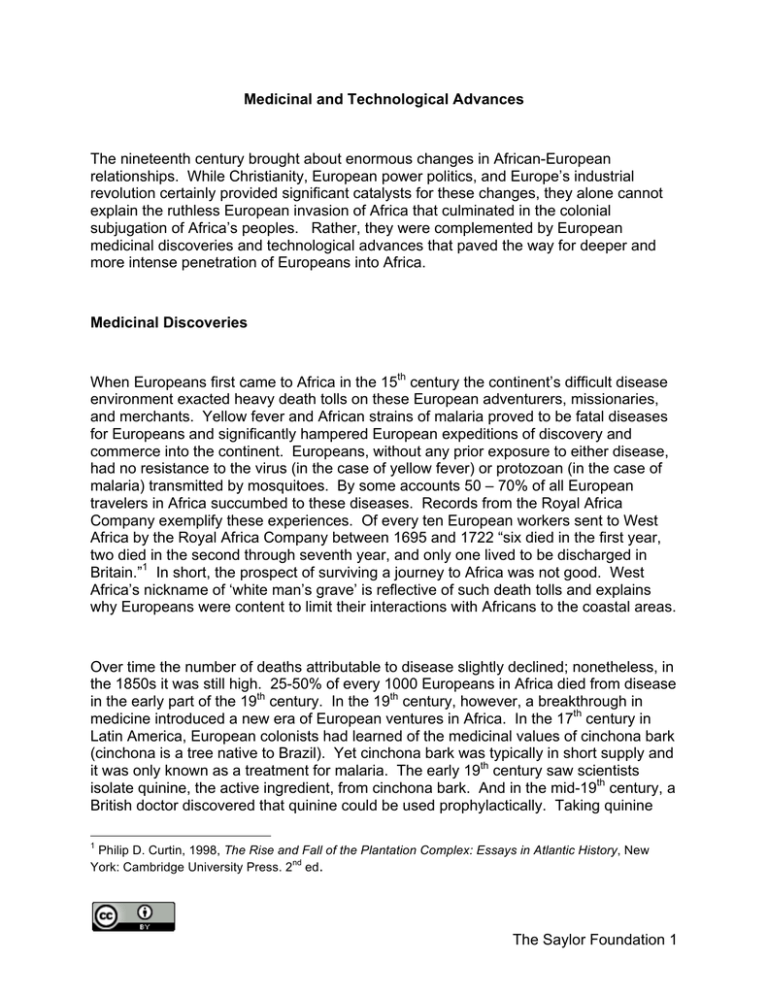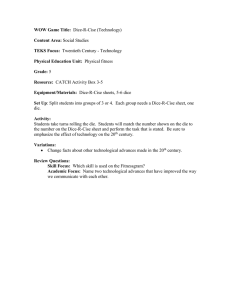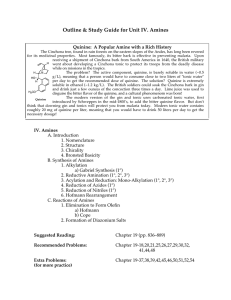The Saylor Foundation 1 Medicinal and Technological Advances
advertisement

Medicinal and Technological Advances The nineteenth century brought about enormous changes in African-European relationships. While Christianity, European power politics, and Europe’s industrial revolution certainly provided significant catalysts for these changes, they alone cannot explain the ruthless European invasion of Africa that culminated in the colonial subjugation of Africa’s peoples. Rather, they were complemented by European medicinal discoveries and technological advances that paved the way for deeper and more intense penetration of Europeans into Africa. Medicinal Discoveries When Europeans first came to Africa in the 15th century the continent’s difficult disease environment exacted heavy death tolls on these European adventurers, missionaries, and merchants. Yellow fever and African strains of malaria proved to be fatal diseases for Europeans and significantly hampered European expeditions of discovery and commerce into the continent. Europeans, without any prior exposure to either disease, had no resistance to the virus (in the case of yellow fever) or protozoan (in the case of malaria) transmitted by mosquitoes. By some accounts 50 – 70% of all European travelers in Africa succumbed to these diseases. Records from the Royal Africa Company exemplify these experiences. Of every ten European workers sent to West Africa by the Royal Africa Company between 1695 and 1722 “six died in the first year, two died in the second through seventh year, and only one lived to be discharged in Britain.”1 In short, the prospect of surviving a journey to Africa was not good. West Africa’s nickname of ‘white man’s grave’ is reflective of such death tolls and explains why Europeans were content to limit their interactions with Africans to the coastal areas. Over time the number of deaths attributable to disease slightly declined; nonetheless, in the 1850s it was still high. 25-50% of every 1000 Europeans in Africa died from disease in the early part of the 19th century. In the 19th century, however, a breakthrough in medicine introduced a new era of European ventures in Africa. In the 17th century in Latin America, European colonists had learned of the medicinal values of cinchona bark (cinchona is a tree native to Brazil). Yet cinchona bark was typically in short supply and it was only known as a treatment for malaria. The early 19th century saw scientists isolate quinine, the active ingredient, from cinchona bark. And in the mid-19th century, a British doctor discovered that quinine could be used prophylactically. Taking quinine 1 Philip D. Curtin, 1998, The Rise and Fall of the Plantation Complex: Essays in Atlantic History, New nd York: Cambridge University Press. 2 ed. The Saylor Foundation 1 prior to traveling in Africa did not absolutely prevent Europeans from contracting malaria, but it significantly improved Europeans’ chances of not contracting it at all or surviving an infection. It is this dual development with respect to cinchona bark in general and quinine in particular that fundamentally altered European’s experiences with malaria. Quinine, then, became Europe’s ticket into Africa. In 1891 alone, Europe imported 20 million pounds of cinchona bark from South America. Quinine became an integral part of every European’s equipment in Africa. Anecdotally, it accounts for gin tonic becoming the drink of choice for European travelers to Africa. These medicinal discoveries involving quinine were paramount developments for allowing Europeans to colonize Africa. Technological Advances Europe’s technological advances also played an important role in the colonization of the African continent. One could argue that the conquest of Africa was a manifestation of the industrial revolution in Europe. Specifically, advances in metallurgy allowed for the skilled and cost-effective production of various products that aided European imperialists in their infiltration of Africa. Examples include the Bessemer Converter, which was developed in the 1860s; it was capable of quickly and cheaply converting pig iron, which is inherently brittle, to the much stronger wrought iron. Also, the SiemensMartin Process lowered the cost of producing steel by 80–90%. These advances in iron technology meant that steel production in France, Great Britain, and Germany could rise over 80 times from 1881 to 1893. Such developments, quite naturally, had significant ramifications for other technologies. The steam engine and the railroad are but two examples. Most importantly in the realm of technological advances are inventions in weapons technology. It is important to note that at the beginning of the 19th century European militaries had very few technological advantages over their African counterparts. Firearms were a popular item that European merchants traded in exchange for slaves during the Atlantic slave trade and the subsequent shift to legitimate trade. Hence, many African states were well-equipped with European weaponry. To illustrate, “[i]n 1829, the British sold 52,540 guns and almost 2 million pounds of gunpowder in West Africa.”2 While the quality of guns traded to Africans was inferior at times, overall there was a unique parity in European and African fire power at the beginning of the 19th century. 2 Erik Gilbert and Jonathan T. Reynolds, 2008, African in World History: From Prehistory to the Present, Upper Saddle River, NJ: Pearson. 2nd ed. The Saylor Foundation 2 However, as the century progressed, European fortunes changed drastically. While the previous century saw very few changes in firearms, the 19th century saw the invention of the bullet and the spiral grooved rifle. The old flintlock musket was replaced by new weaponry, which proved much more efficient. Specifically, the flintlock musket was very time consuming to load and not very accurate. This compared unfavorably to the new breech-loading guns that, with the combination of bullet and powder, could be fired approximately ten times faster than the old muzzle-loaders. In 1871, the British used such new spiral grooved rifles against the Xhosa in southern Africa; the British won a decisive victory against the Xhosa who were using old muzzle-loading guns. Developments in weapons technology continued throughout the century to include the invention of the Winchester repeater and, in the 1880s, the Maxim gun. The latter is considered to be the prototype of the modern machine gun and proved to be the decisive factor in many battles. European militaries quickly updated their weapon arsenals to reflect these new developments in weapons technology. Simultaneously, European powers ensured that Africans would not be able to obtain such weaponry. The Brussels Convention of 1890, designed to provide measures to counteract the slave trade and slavery, expressly prohibited the sale of modern weaponry to Africa. Inventions in weapons technology, in conjunction with European powers’ intent of keeping the new weapons out of African’s hands, were critical developments in the history of European imperialism. The conquest phase of European colonialism in Africa, then, was clearly enabled by the combination of medicinal discoveries and technological advances. From the 1880s onwards, Europeans could live in Africa without dying en masse from disease and enjoyed superior weapons technology. The Saylor Foundation 3






